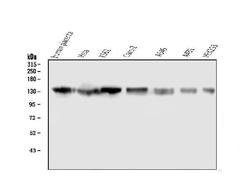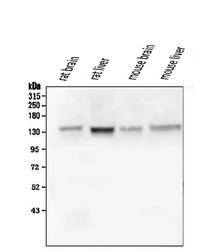Antibody data
- Antibody Data
- Antigen structure
- References [3]
- Comments [0]
- Validations
- Western blot [1]
Submit
Validation data
Reference
Comment
Report error
- Product number
- M05865-2 - Provider product page

- Provider
- Boster Biological Technology
- Product name
- Anti-GM130 GOLGA2 Antibody Picoband™ (monoclonal, 6D4)
- Antibody type
- Monoclonal
- Description
- Mouse IgG monoclonal antibody for GM130 detection. Tested with WB, IHC-P, ICC/IF, FCM in Human;Mouse;Rat.
- Reactivity
- Human, Mouse, Rat
- Host
- Mouse
- Isotype
- IgG
- Antibody clone number
- 6D4
- Vial size
- 100μg/vial
- Concentration
- 0.5-1mg/ml, actual concentration vary by lot. Use suggested dilution ratio to decide dilution procedure.
- Storage
- At -20°C for one year. After reconstitution, at 4°C for one month. It can also be aliquoted and stored frozen at -20°C for a longer time. Avoid repeated freezing and thawing.
- Handling
- Add 0.2ml of distilled water will yield a concentration of 500μg/ml.
Submitted references Label-free nonlinear optical signatures of extracellular vesicles in liquid and tissue biopsies of human breast cancer.
Extracellular vesicles from organoid-derived human retinal progenitor cells prevent lipid overload-induced retinal pigment epithelium injury by regulating fatty acid metabolism.
Tetramethylpyrazine ameliorates endotoxin-induced acute lung injury by relieving Golgi stress via the Nrf2/HO-1 signaling pathway.
Sorrells JE, Park J, Aksamitiene E, Marjanovic M, Martin EM, Chaney EJ, Higham AM, Cradock KA, Liu ZG, Boppart SA
Scientific reports 2024 Mar 6;14(1):5528
Scientific reports 2024 Mar 6;14(1):5528
Extracellular vesicles from organoid-derived human retinal progenitor cells prevent lipid overload-induced retinal pigment epithelium injury by regulating fatty acid metabolism.
Gao H, Zeng Y, Huang X, A L, Liang Q, Xie J, Lin X, Gong J, Fan X, Zou T, Xu H
Journal of extracellular vesicles 2024 Jan;13(1):e12401
Journal of extracellular vesicles 2024 Jan;13(1):e12401
Tetramethylpyrazine ameliorates endotoxin-induced acute lung injury by relieving Golgi stress via the Nrf2/HO-1 signaling pathway.
Li S, Xu Y, He S, Li X, Shi J, Zhang B, Zhu Y, Li X, Wang Y, Liu C, Ma Y, Dong S, Yu J
BMC pulmonary medicine 2023 Aug 7;23(1):286
BMC pulmonary medicine 2023 Aug 7;23(1):286
No comments: Submit comment
Supportive validation
- Submitted by
- Boster Biological Technology (provider)
- Main image

- Experimental details
- Western blot analysis of GM130 using anti- GM130 antibody (M05865-2). Electrophoresis was performed on a 5-20% SDS-PAGE gel at 70V (Stacking gel) / 90V (Resolving gel) for 2-3 hours. The sample well of each lane was loaded with 50ug of sample under reducing conditions. Lane 1: human placenta tissue lysates, Lane 2: Hela whole cell lysates, Lane 3: K562 whole cell lysates, Lane 4: Caco-2 whole cell lysates, Lane 5: A549 whole cell lysates, Lane 6: A431 whole cell lysates, Lane 7: HEK293 whole cell lysates. After Electrophoresis, proteins were transferred to a Nitrocellulose membrane at 150mA for 50-90 minutes. Blocked the membrane with 5% Non-fat Milk/ TBS for 1.5 hour at RT. The membrane was incubated with mouse anti- GM130 antigen affinity purified monoclonal antibody (Catalog # M05865-2) at 0.5 μg/mL overnight at 4°C, then washed with TBS-0.1%Tween 3 times with 5 minutes each and probed with a goat anti-mouse IgG-HRP secondary antibody at a dilution of 1:5000 for 1.5 hour at RT. The signal is developed using an Enhanced Chemiluminescent detection (ECL) kit (Catalog # EK1001) with Tanon 5200 system. A specific band was detected for GM130 at approximately 130KD. The expected band size for GM130 is at 130KD.
- Additional image

 Explore
Explore Validate
Validate Learn
Learn Western blot
Western blot Immunocytochemistry
Immunocytochemistry